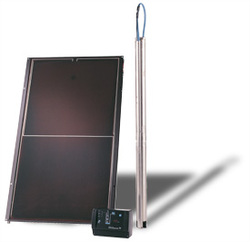A solar water pump produces the most water when it’s sunny and dry.
As luck would have it, that just happens to be when we need the most water.
This is just one of the reasons that solar power and water pumping are a match made in heaven.
Another reason that pumping with solar power makes sense is that you can pump all day and use the water whenever you want.
The two main uses for solar powered pumps are:
1. Pumping water for livestock in remote areas
2. Providing water for an off-grid home
Your solar pump system will include:
- A pump
- A pump controller
- (linear current booster)
- Solar panels
- A storage unit
Depending on your water supply, you will require either a surface pump or a submersible well pump.
A surface pump will do the trick if you will be pumping from a surface water source such as a pond or lake or a very shallow well.

A surface pump is cheaper than a submersible pump but it can only draw water vertically about 20 feet.
Once it has drawn the water from the well, however, a surface pump is capable of “pushing” it hundreds of feet.
If your well is deeper than twenty feet, you’re going to want a submersible pump. These babies are capable of pulling water hundreds of feet out of a well.
So, what makes a pump suitable for solar power?
Well, traditional pumps are 220 volt AC models. These are not very efficient and they require a lot of power to start up.
You’re going to want a pump that operates on DC (direct current) and is designed to run on a minimum of electrical power. Also, a good solar water pump will not require a high surge of current in order to start.
A pump controller (linear current booster) is your pump’s best friend.
It will start your pump earlier in the morning and keep it pumping longer in the afternoon.
It will also keep your pump operating under lower light conditions when the pump would otherwise stall.
A pump controller controls the current between the solar panels and the pump and protects the pump from current fluctuations. It also prevents the pump from running dry.
Now as you may have guessed, a pump that uses less power tends to pump less water. This means you will have a lower flow rate than if you were using a traditional AC pump (sometimes your flow rate will be less than one gallon per minute).
This means that you’ll want a storage unit that your solar powered pump can fill while the sun shines. A tank that can hold several days usage will ensure you have water even when you go through a cloudy stretch.
And how many solar panels will you be needing to pump all this water? A small pump can operate on a single solar panel while a larger pump usually require two panels. The main factors that will affect how many panels you need are:
- How much water is required per day
- How high the water has to be pumped (vertical head)
Solar pump manufacturers provide a table showing how many watts of solar are needed for a specific pump to provide a certain amount of water.
Once you’ve pumped your water from your well to your storage tank you’re going to have to think about water pressure (After all, what good is a storage tank full of water that won’t come out of your faucet?).
Here are a few different ways you can handle this:
- Pump your water from the well to a pressurized tank (Beware: This can put quite a strain on your solar water pump)
- Use a separate booster pump to pressurize a smaller secondary storage tank
- Elevate your storage tank and gravity feed the water to your home
Now that you know the basics, here are a few solar water pump manufacturers and some of their product lines:
- Grundfos
- SQFlex submersible pumps
- SHURflo
- 9300 Series Submersible Pumps
- 2088 Series Surface Pumps
- Lorentz
- PS Series Submersible Pumps
- PS600 BADU Top 12 High Volume Surface Pump
- PS150 Boost Booster Pump
- Conergy
- Solar Slowpump Surface Pump
- Flowlight Booster Pump
- Suncentric Centrifugal Pump
- Solaram Surface Pump
- Solar Force Surface Pump
